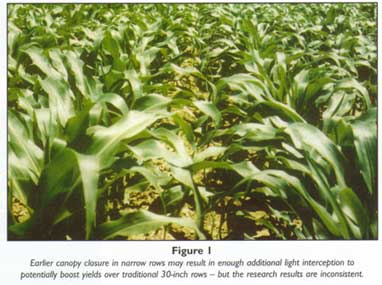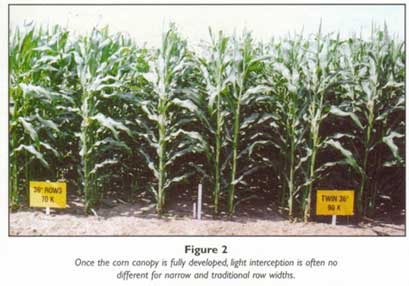
Current Issues in Crop Development
The
following is a list of crop development and management highlights from presentations
given at the 2001 Southwest AgConference.
1)
Numerous studies on narrow row (less
than 30 inches) corn across North America over the past decade have been
inconclusive as to the actual yield benefit to expect. Some results indicate
as much as 8-10 per cent advantage while others predict no yield advantage
to rows less than 30 inches. It is probably difficult to justify narrow
row equipment costs based solely on increased corn yields, but the picture
improves somewhat if equipment harmonization produces savings or efficiencies
(e.g., same 20-inch row planter for corn, soys, edible beans)
2)
As a theoretical rule of thumb, achieving
canopy cover (maximum light interception) 1 day earlier in the season translates
into 2 bu/ac additional  yield. This concept applies for rows that canopy
sooner because they are planted closer together, but it also applies to
corn that is planted earlier, experiences less stress, enjoys balanced fertility,
etc. How much more quickly do 20-inch rows reach maximum light interception
than 30-inch rows? The difference is actually not that great: perhaps 1-3
days, thus theoretically boosting yields by 2 to 6 bu/ac.
yield. This concept applies for rows that canopy
sooner because they are planted closer together, but it also applies to
corn that is planted earlier, experiences less stress, enjoys balanced fertility,
etc. How much more quickly do 20-inch rows reach maximum light interception
than 30-inch rows? The difference is actually not that great: perhaps 1-3
days, thus theoretically boosting yields by 2 to 6 bu/ac.
3)
Once both 20-inch and 30-inch row corn canopies are fully
developed, they intercept the same amount of light and there is no additional
yield gain to be obtained. As rows widen beyond 30 inches, however, the
ability for the canopy to intercept a high percentage of the sunlight starts
to fall off. Selecting ultrawide rows (greater than 40 inches) is a sure
way to generate a 10 per cent yield loss.
4)
Confused over GDUs or GDDs versus Ontario CHUs? Both are based on temperature,
but they are calculated quite differently. There is no single factor that
will allow you to convert one to the other, but if you must: GDU x 1.3
is approximately equal to CHU. Also, there is no advantage to the GDU
approach; in fact, research indicates that the CHU system is slightly
more accurate at predicting corn crop development.
5)
What are the advantages to early
silking in corn hybrids? Simply put they are:
a) allow for the life cycle to be completed - maturity before killing frost
b)
higher solar radiation during grain filling - delayed silking results
in grain filling that occu rs during a period of lower light
intensity and reduces yield potential
rs during a period of lower light
intensity and reduces yield potential
c)
warmer temperature during grain filling. Generally, earlier silking is
an advantage and usually means earlier to black layer - but there are
differences in how rapidly different hybrids fill their grain. Some later
silking hybrids may still be capable of filling more rapidly and reaching
maturity as quickly as earlier silking hybrids.
6)
On the hybrid selection front, considerable progress is being made in
the ability to rank hybrids from 'unbalanced' strip trial data. By unbalanced,
we mean the type of data that is gathered from a large number of on-farm
strip trials where hybrids that you would like to compare or rank don't
actually appear side by side in the same test that often. Weikai Yan and
Dr. Tony Hunt from the Department of Plant Agriculture at the University
of Guelph have developed a system where this data can be analyzed to give
an indication of the hybrid or cultivars' relative performance similar
to a situation where they all appeared in a performance trial. This exciting
new approach can give considerably more power to our hybrid selection
process. Of course, one of the keys to making it all work is to have those
hybrids with significant potential appear in a reasonable number of on-farm
strip trials. Be sure to put a good range of proven performers and emerging
stars from various companies in your hybrid trials this year.
7)
The theoretical maximum yield for corn is calculated by Dr. Tollenaar
to be about 470 bu/ac. Record yields over the past few decades have approached
400 bu/ac. Must you plant some freakish 'racehorse'-type hybrid to achieve
these record yields? An analysis of the hybrids used to obtain some of
these record yields actually indicates that they often could be considered
'workhorse' hybrids which yielded as well or better than the average in
poorer, low yielding environments. High yield potential, however, is still
one of the most important considerations for corn growers. The point to
remember is that nearly all elite, high potential hybrids will have their
defects. Good hybrid selection requires that you obtain as much of this
information as possible and select for genetic diversity. If you are selecting
two racehorse hybrids for your early planting, be sure that they complement
each other and do not have the same inherent weakness, e.g., low stalk
strength.
8)
The most economic rate of nitrogen for a corn crop depends on many factors,
including weather conditions, soil texture and organic matter, previous
crops, manure applications, etc. The soil nitrate test has been used with
some success to evaluate the impact of these different factors on the amount
of nitrogen that will be made available by the soil, and hence, how much
fertilizer N should be applied to reach maximum economic returns from the
corn crop. This approach to predicting nitrogen requirements (as well as
other approaches) is most meaningful to growers when accompanied by some
in-field verification to assess the actual amount of nitrogen required by
the crop. This requires a series of plots or strips receiving different
rates of nitrogen. There are numerous ways to set up these strips. Here
are three suggestions:
|
Flag Colour |
Sidedress
Applicator |
|
White |
0 |
|
Yellow |
45 |
|
Orange |
90 |